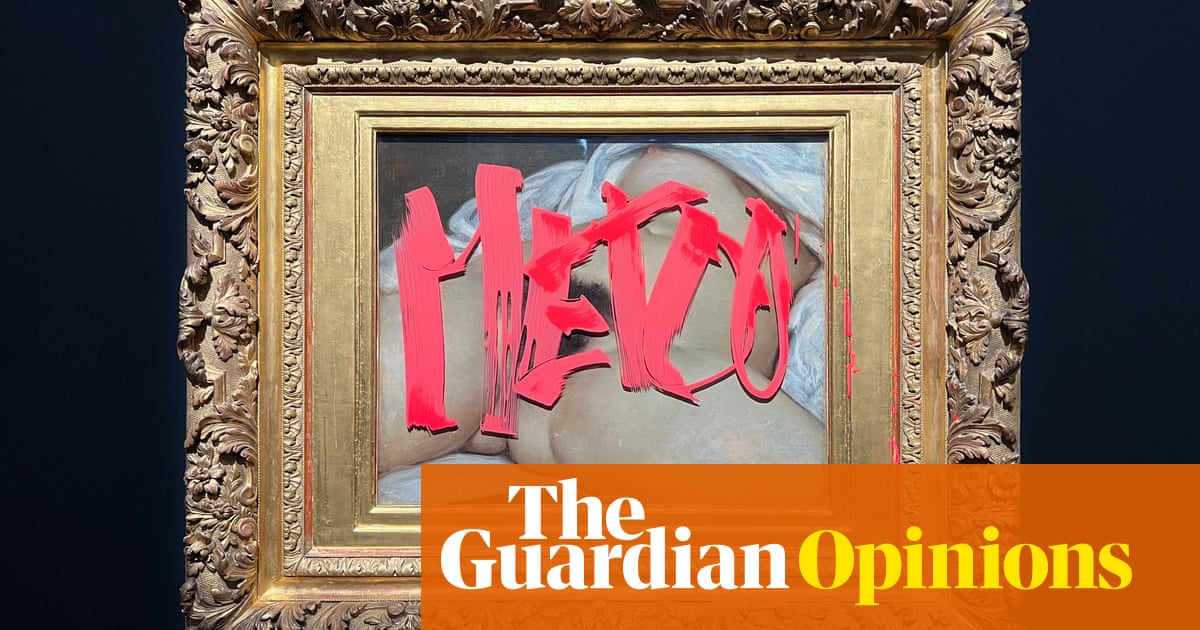On Monday afternoon, a group of feminist artist-activists tagged “MeToo” in red paint on Gustave Courbet’s L’Origine du Monde. Currently on loan to the Centre Pompidou-Metz for an exhibition dedicated to the psychoanalyst Jacques Lacan, the painting is a notoriously tight close-up of an unnamed woman’s vulva. It has never not been startling. It operates as a kind of social lightning conductor, consistently illuminating the invisibility women too often experience – in art as in life.
Luxembourgeois artist Deborah de Robertis, who is also exhibiting in the show, has claimed authorship of the action. Its title, she’s said, is On Ne Sépare Pas La Femme de l’Artiste, which translates as “You do not separate the woman from the art.”
The response, from both the political and the artistic establishments, has been hostile. The museum condemned it as an act of vandalism, the mayor as a criminal attack perpetrated by fanatical feminists. Two women have been arrested.
This comes after several actions by Just Stop Oil at which famous paintings were attacked. Yet to me there is a difference between throwing tomato soup at a famous painting of sunflowers and a feminist artist tagging the anti-misogyny battle cry of the 21st century on to a painting famous for reducing the woman it depicts to her sexual organ. She doesn’t even have a face.
In 2013, when a male Courbet expert “confirmed” that a newly discovered painting of a head was actually that of this model (it wasn’t), he reportedly said that making the woman whole essentially devalued Courbet’s work. “The Origin of the World loses that kind of marvellous mystery and symbolism from the moment you stick a head on it – that’s why Courbet took it off.”
By contrast, when an art writer once commented to the art historian and altogether more feminist Courbet expert Linda Nochlin, that, given the angle Courbet had chosen, it shouldn’t be possible to see the woman’s left breast, Nochlin lay on the floor (with her clothes on) to demonstrate, with her whole own female body that, actually, it really is.
Lacan owned the painting for three decades but hid it behind a custom-made wooden screen. Until the late 1980s, even experts doubted it still existed. All anyone knew of it were historic accounts by pundits who’d seen it and been revulsed (not by Courbet’s skill but by the body part on display) and reproductions in black and white. These were so grainy that Nochlin highlighted how indistinguishable this made the work from basic newsstand porn.
Before she finally secured the loan of the painting for the Brooklyn Museum’s seminal Courbet Reconsidered show in 1988, Nochlin wrote a whole paper about the efforts to locate it. She noted the Freudian import of both the title and of her quest to find the original Origin. She described how prehistoric depictions of vulvas have been said to be at the origin of art itself. She concluded that the search for lost origins leads to blindness.
De Robertis’s work homes in on an altogether more urgent blindness. You could say that her point, with this performance, is that the woman in the painting never lost her head or her name. She was there all along – all of her. And that saying so really matters.
The artist’s detractors on social media have been piling on the insults: she’s a degenerate, an idiot. But among the other works the performance targeted is a work of her own. A photograph titled Miroir de l’Origine du Monde (Mirror of the Origin of the World), documents a performance she did in 2014, wherein she sat beneath Courbet’s painting, in situ at the Musée d’Orsay, and exhibited her own vulva until the police intervened.
It’s a considered, confronting gesture that she has repeated in other charged locations (in front of the Mona Lisa; at the Grotto of Apparitions in Lourdes, where the Virgin Mary is said to have appeared in 1858). And each time, just as activist group Femen do with their topless actions, it is a great big shout to not look away, not deny women their wholeness, their right just to be.
after newsletter promotion
In 2016 Swedish graphic artist Liv Strömquist’s best selling comic, Fruit of Knowledge: the Vulva vs the Patriarchy, was translated into French, under the title, you guessed it, L’Origine du Monde. The Courbetian reference was apt. Riffing on the idea that too many men throughout history have spent way too much time obsessing over female genitalia but not seeing the women it’s appended to, the comic is a bracing look, as one commenter put it, at just how far we haven’t come. Another rightly called it a public health manual.
De Robertis’s performance comes within days of the French parliament approving the creation of an enquiry into sexual violence within the arts. It comes less than a month of arguably the most famous #MeToo conviction being overturned. If the question, “Would you rather find yourself alone in the woods with a bear or a man?” has been trending on social media, it’s because sometimes you need to ask bonkers questions – or do bonkers actions – to get a point across. As gender violence expert Lisa Sugiura has put it: “This continuum of misogyny is women’s everyday reality – and at no point do bears feature.”
